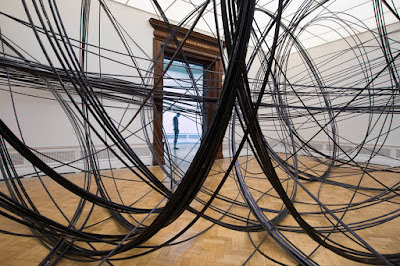 |
| Antony Gormley, Iron Baby, 2019 |
Inside the
courtyard, we can be forgiven for stumbling over the cast Iron Baby. Those who do stop to examine the piece are asked to begin
questioning all that they know about art, about the Royal Academy, about
courtyards and babies. My first response was to bend down and look at Iron Baby, its face to the ground, legs
and arms tucked under its tiny body. My impulse was to bend down and see if it
needed help, to rescue it. This call to our emotive response as a way to
connect with his sculptures is typical of Gormley’s art. I had so much fun
watching people engage with the casts of Gormley’s naked body, scattered around
the floor, walls and ceiling of the room titled, Lost Horizon. The works draw visitors because they are human in
scale, form and posture, only to disappoint because they are inhuman in their
material of cast iron and their ability to defy gravity. It’s the human in them
and the human in us that come together as Gormley transgresses the structural
imperatives of the museum. But it is the vulnerability of the baby, and even
more so of the Slabworks that I makes
them intellectually challenging, throwing us back on our desire to come close. The
Slabworks are not even given human
form. They are slabs of weathering steel, put together to give the impression
of a human form. One piece lies on its side, apparently in agony – or perhaps
it is dreaming – another leans against the wall, as if waiting for a light, one
is perfectly supine, perhaps about to be delivered inside a full body scan
because it is sick. We attribute human characteristics and emotions to steel,
this most intransigent and unrelenting of materials. And then, having stepped
back as we recognize their inhumanness, the figures arouse our emotions, as
though they are reaching out to touch us.
The quality
for which Gormley’s work is perhaps best known, is its transformation of spaces
– making the gallery into a fun park if nothing else. The piece in this
exhibition that most brilliantly does this is Clearing VII (2019) in which something like 8km of aluminum tube
becomes a knotted mess, filling the entire volume of one room. The radicality
of the work is again in the way that it transforms the gallery space. It fills
the negative space of the room, pushing visitors to the edges, challenging us
to navigate our way to the door on the other side of the space. We duck and
bend, contort our bodies as we try to avoid stepping on the aluminum – because
as good museum visitors we have been trained not touch the art work. Of course,
the getting lost inside the maze of steel is just the point. There is nothing
to see here, nothing to look at because it is just one big steel mess. Instead
we have an experience, like that of an obstacle course to navigate. We meet
sculpture that pushes us out of the way. The steel is uniform, unyielding, though
it can be very beautiful in the light. Other of Gormley’s works are anything but
beautiful.
 |
| Antony Gormley, Matrix III, 2019 Installation View |


No comments:
Post a Comment